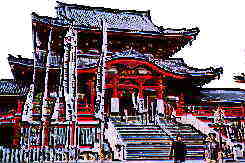(KITANO-SAN SINPUKU-JI HOSHO-IN)

History of Osu Kannon Temple
| It dates back to the Kamakura era(1192-1333).
In 1324,Kitano Tenmangu was built in the present Hashima City in Gifu prefecture by order of Emperor Godaigo(reign 1318-39).They dedicated this shrine to Sugawara Michizane(Tenjin-sama 845-903) as a god of education. |

The crest of the 'plum blossom' |
There were always many plum trees planted with in the precincts.As
he was fond of plum blossomes since his childhood.In those days ,it was
regarded as the most noble and beautiful flower among the others.
The crest of the 'plum blossom' is the symbol of the Tenjin-sama.It has been used as the crest of our temple for this reason. |
|
The principal image of Osu kannon is the statue of Kanzeon-bosatsu.It was
carved by kobo-daishi who was a priest in the fast of Heian era.
Kanzeon-bosatsu is commonly called kannon-sama(the goddess of mercy,the salvation goddess).It is the most popularly worshiped Buddhist saint in Japan.People believe that Kannon-sama would grant their wishes.Its facial expression is tender and gentle. After that Osu kannon Temple expanded its territory to have Ichiman-koku(It is mean that the territory makes the rice of about 1,800 kiloliters)and became a branch temple of 335 Shingon-Buddhism sects.It is said that 428 priests participated in the Buddhist service of one-hundred kaiki,a Buddhist memorial mass. In Azuchi-momoyama era(1576-1600),following decades of the civil war,Oda Nobunaga contributed his five-hundred koku territory. However,in those days,Osu Kannnon Temple situated at the large shallow area surrounded by the Kiso and Nagara river and served for a strategic position.In Edo era(1603-1868),in order to protect the Togugawa family in Owari,the river bank was constructed intentionally higher than the one of Mino distinct in which original Osu Kannnon Temple by three-jyaku(approximately 90.9cm).So it was flooded many times.At last the flood in 1605 washed away the temple except some treasures of it including some valueable books.For the security of this residuum,the temple was moved to the present place by Tokugawa Ieyasu in 1612.At that time the place was changed from Hiokimura-village to Osu. Seeing from the political point of view,this could be one of the strongholds to protect the south side of Nagoya Castle. In Bunsei era(1820's),100 years after the temple was moved to the present site,unfortunately the pagoda was burned down in the big-fire in Meiji era (1868-1912) together with the main temple,the shoin,(the living quarters of the temple),Kannon hall and the gate with Two Deva Kings.The present main temple was reconstructed in 1970.It took three years and costed 750 million yen(about 580 thousand dollars). |
| KITANO-SAN SINPUKU-JI HOSHO-IN 21-47 Osu 2-chome Naka-ku Nagoya Phone (052)231-6525 |